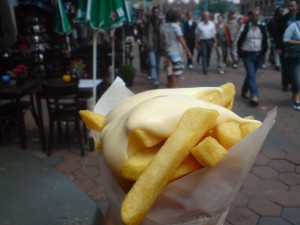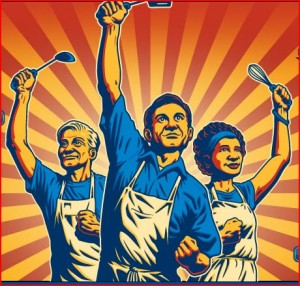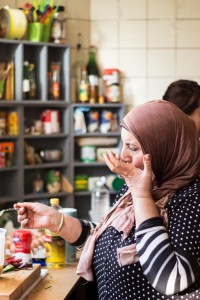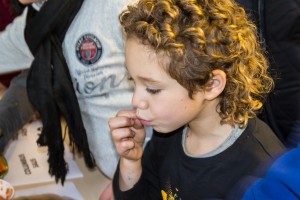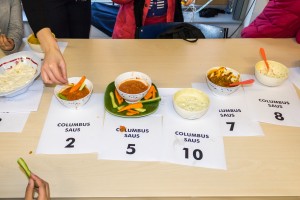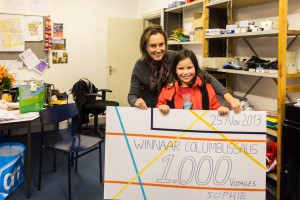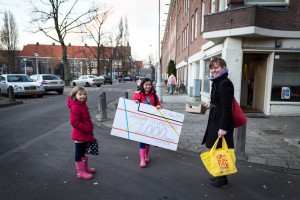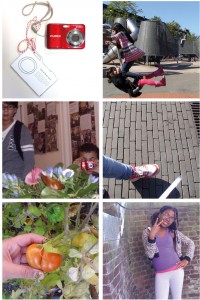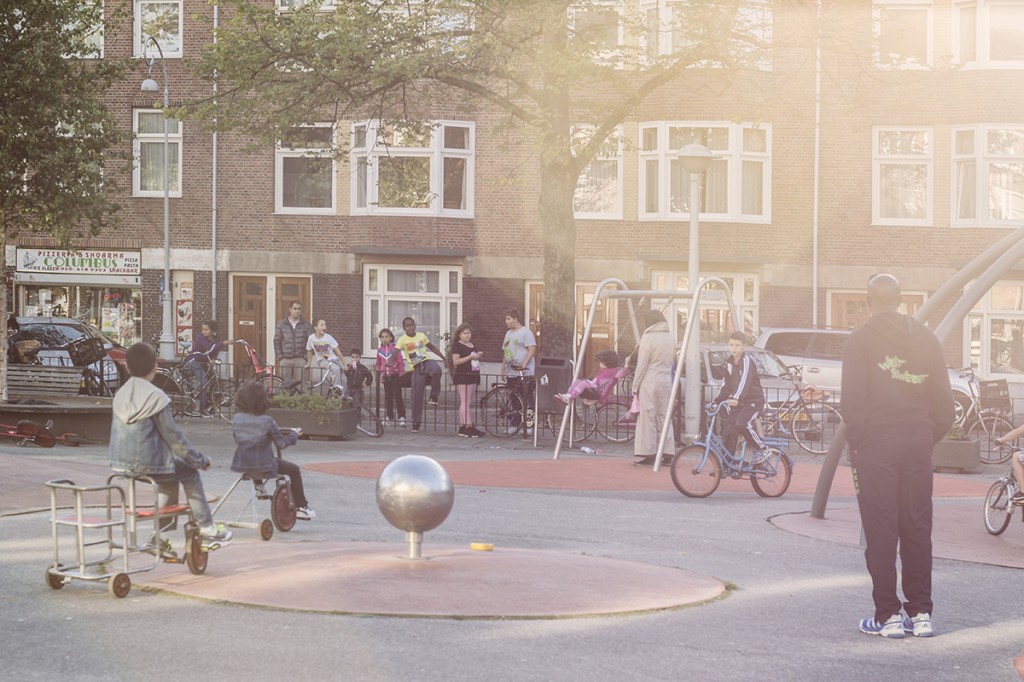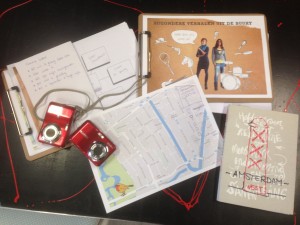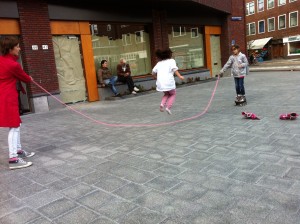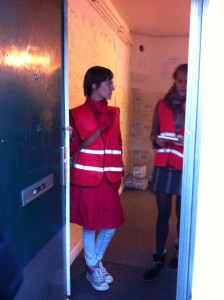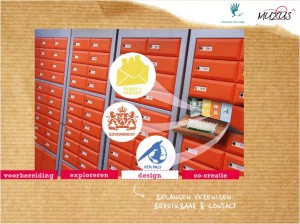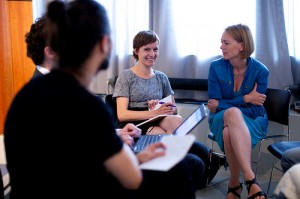Wicked Problem #1: Efficiënt genetwerkte overlast op het Columbusplein.
The People’s Republic of Columbusplein coming into existence
From a kids perspective there’s other things important to form a nation than from a grown-ups perspective. It’s not government, elections or traffic signs. It’s food, sports, art, music and more. Especially about food the kids are really enthusiastic. Do we know tajine? Have we eaten roti? Are we fond of baklava too?
Kids love fries. But what do Columbusplein kids have with their fries? And what do the mums use as an alternative to the dutch mayonnaise? To determine the flavors of Columbusplein a Secret Fries Sauce Contest took place on November 25.
Mums and a dad from a variety of backgrounds prepared about 10 different sauces that could make ‘the flavor of Columbusplein’. When the Visserschool was out the kids created their version of Columbussaus, some with their mum, some with their friends. And then the grande finale, the local snackbar owner brought enough fries for everybody and the election of Columbussaus was a fact:
Sophie, 9 years old, a girl from the Visserschool, won the cheque of a 1000 voyages!
Public presentation @ DDW Eindhoven, October 24
We, the design team, presented the concept of the micro nation at October 24: the People’s Democratic Republic of Columbusplein. For us this is a framework, a tool that helps us to create a positive common denominator at Columbusplein. During and after our presentation we noticed that not everybody sees it this way. The micro nation concept is by some perceived as something sturdy and fixed, that has dangers in it of war, nationalism and mis-use of power. Whereas we want it to be used as a way to emphasize the positive things at Columbusplein and create a common ground amongst its citizens.
The micro nation concept emphasizes that little seed of identity that already exists, instead of create a whole new ‘extra’ identity. It leads to a feeling of belonging, a common history that ties the people living there together and make them proud of their neighborhood, themselves and each other.
The People’s Republic of Columbusplein can be recognizable by means of typical visual elements on the square, by its local flavors, by the local economic system, by activities that citizens, businesses and other organizations do and feasts that they celebrate. It binds them al together and forms a base for the decisions they make. Whether it’s the sauce they eat on their fries, the space program they run, the olympics their organize, it’s shared and it’s positive.
Zo snel kan het opeens gaan – 15 october
In mijn beleving is het niet meer dan 2 weken geleden dat wij elkaar spraken, Neele, Tabo en Jenny van Elsevier en ik. Na een uur gezamenlijk goed puzzelen op de bevindingen van Neele en hoe we deze op een andere manier zouden kunnen “framen” zijn we uit elkaar gegaan met de afspraak dat er nagedacht zou worden over het kiezen van een thema van waaruit we het complexe probleem zouden aanvliegen.
1 We want people to realise how important and significant public spaces like Columbusplein are in our cities, and the possibilities it offers to their neighbours and visitors.
2 We want to provide kids with new mechanisms that will allow them to express themselves in a positive way.
3 We want to create a feeling of belonging within the local community of Columbusplein, a new identity, an imaginary nation that invites people to feel proud and take part in their own neighbourhood.
4 We want this identity to be useful for all the social organisations working in the area, inviting them in a more positive approach.
5 We want to come up with new strategies for the neighbourhood, and different approaches for some of the activities that already exist.
Show yourself! – October 1 2013
Last Friday we did some street research again. We went to the local school on the Columbusplein and asked several children to show us their neighborhood. To help them express themselves, we supplied them with cameras and some inspiring assignments.
Here you can see a small impression of their snapshots!
We were positively surprised by the great enthusiasm of the children wanting to participate and show us their home, environment, friends, and things they find important. They wanted to help us so eagerly, they were fighting for it! (just kidding!) The kids were very nice and polite, carefully used our camera’s and research material, while a lot of grown ups actually warned us that some camera’s might go missing.. The kids took the assignment quite serious. Kept coming back to ask us what it was exactly that we wanted them to show us. They took great pride in showing a part of themselves and of their daily life.
Besides the children we also met a group of mothers who are active in the neighbourhood, and we observed some other mums who were visiting the playground with their kids. The active mothers come together twice a week to talk about neighbourhood issues and to organise activities. We joined their meeting and overheard many plans, from organizing a sheep festival to planning an autumn activity and Christmas party… They said they could never achieve what they do without the help of the people in the BPT.
Two of the active Surinam mothers showing us around in de Baarsjes:
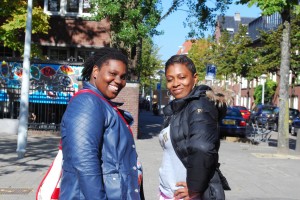
The mums who visit the playground with their kids used the members of the BPT in another manner. The sports coach being there seemed to be watching their kids, instead of the mums themselves, warning them not to play too rough. The mothers could just keep on chatting, and did not even turn their head around when one of their little boys got scared and sat crying on a crazy swing. Sports monitor will solve it?
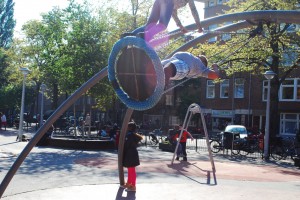 especially this swing is used to go crazy
especially this swing is used to go crazy
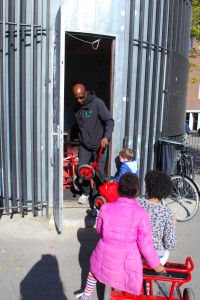 The sports monitor who watches the kids playing
The sports monitor who watches the kids playing
About Columbusplein – September 27 2013
Columbusplein is a vibrant public square in West Amsterdam. A public space that any district or city would wish to have. Filled with several playgrounds, swings, sport fields, benches and trees, it is a daily reunion place for several families and their kids who live around the neighbourhood. A great number of organizations, social workers and volunteers work in the area providing several activities and support for those who might need it. But in a sunny Friday afternoon, after the public school closes its doors and Columbusplein is at its peak time, it is hard to believe that this is the wicked problem scenario we’ll be working on.
Underneath the surface, Columbusplein is an extremely complex area, with a very mixed ethnic population, relating to different factors such as nationality, culture, ancestry, language and beliefs. This fact has a large impact on the way the space is understood by several urban communities. People of all ages and from different backgrounds come together in one single place, leading to some inevitable friction. I believe it is particularly the young kids who find this situation more confusing, being in a permanent quest for their own social identity and status, especially the ones who spend more time in the streets. These kids seem to be open to new social interaction strategies, as long as these allow them to express themselves and their own interests.
We’ve been literally overwhelmed by the amount of energy that is put in this area by social workers, volunteers and their organisations, making this project even a greater challenge for us. Diverse events are hosted around the area as neighbourhood actions program. But despite the unquestionable positive effect that these activities might achieve, their ephemeral nature makes them only effective on a very short-term basis. The most recent example is “Fresh in de les”, a great opportunity for us to learn from the dynamics of these kind of initiatives. Part of this activity (the second time is has been implemented) consists on putting social workers out in the streets, dressed with flashy orange vests, looking for kids who are still hanging around in the evening, hoping to write down their name, address, school… and explain them how important it is to be home early and ready for the next day at school. What is actually a good strategy gets spoiled by what might be a wrong approach, and the evening “Fresh in de les” becomes the daily game of cat and mouse. Kids have even created their own communication system to avoid being catch by the “guys in orange”, proving their creativity and collaborative skills when it is on their own interest.
After only a few weeks in the neighbourhood I see Columbusplein as a unique urban environment, with mechanisms and social interactions of its own, especially for the youngest ones. But somehow, a place that is lacking a stronger cohesion between people, a sense of belonging. The idea of gathering every one under the same umbrella encourages me to envision Columbusplein as some sort of imaginary microstate of its own. A land where kids are welcomed to design and create their own identity according to their own personal taste, but at the same time feeling proud of belonging to the same place, the same square, regardless their social or ethnic background. Columbusplein becomes something more than just the place where they hang out.
A sports monitor keeps an eye on some kids in Columbusplein.
Creating first insight – September 20 2013
In order to get a feel for the motivations of people in, around and concerned with the square, we are doing some quick qualitative investigations. We used a map and a sociogram to get people on the square to talk about where they live, what they do on the square, what they find important in the neighborhood and what are there motivations to make certain choices.
After a few interviews the material was evaluated and improved for our visit this week, next Friday we’ll speak to parents and children visiting the square, a teacher who worked at the school facing the square and decide on our direction in this project!
First impressions – September 13 2013
To start we are trying to get a feel for what’s going on on the square and in the neighborhood. Therefore we went along with a lot of the activities that are being organized by the different organizations (14 organizations are active here!) on and around Columbusplein. We participated in drinking tea at the Witte de Withplein, where recently a ‘shop’ was set up to get a feel for the people and activities around this particular square, and decide whether this is also a place where a Buurt Praktijk Team (BPT) should be active. The shop builds a connection with the people living around the square, by making conversation and offering tea and coffee, with the youngsters who meet up at the square, by observing them, and with the kids playing at the square, by giving them things to play with and chatting with them.
We also joined Fresh in de les. This is an initiative that addresses children that are playing on the squares in the neighborhood late in the evening. Fresh in de les brings them home and emphasizes that, to be in time for school, it is important to go to bed in time. In the morning a coffee bike serves the parents coffee and gives the children breakfast. Also, several activities such as ‘ochtend gymnastiek’ are organized in the morning. We went along with the evening round, and walked by all the squares in the surroundings:
The above gave a lot of input, and made us realize it is necessary to start working from a specific focus soon. So the next post will probably contain more about this!
From this week on, we will be shadowed by a journalist from Elsevier, Jenny Velthuys, who will write an article on social design and the case in Amsterdam West in a few weeks.
Kick-off – September 6 2013
Door May-Britt Jansen van Stadsdeel West in Amsterdam wordt op de Kick off bijeenkomst van 6 september het vraagstuk geïntroduceerd. Ze legt uit dat er al jaren veel overlast is van jongeren die zich misdragen op het Columbusplein in Amsterdam. Het is een heel complex probleem, de gemeente is al decennia bezig met het aanpakken van jeugdoverlast op verschillende plekken in de stad. In de drukbevolkte buurt de Baarsjes zijn straatcoaches ingezet en worden met jongeren zogeheten ‘portiekgesprekken’ gevoerd om hen op hun gedrag aan te spreken. Veel buurtbewoners hebben echter het vertrouwen in de politie en het stadsdeel verloren. Tegelijkertijd onderneemt de politie geen actie als bewoners geen aangifte doen. De urgentie om in te grijpen lijkt verloren te zijn geraakt.
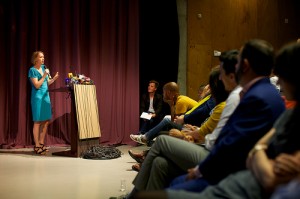
In de Baarsjes buigen maarliefst veertien welzijnsorganisaties zich over het probleem. Zij houden zich vast aan de activiteiten die ze hebben opgezet. Doordat er geen grens wordt gesteld op het plein is er geen gezag. Ouders voelen zich niet verantwoordelijk voor het gedrag van de jongeren. Er zijn vliegende brigades die bij incidenten worden ingevlogen door de burgemeester.

Bij de aanpak van een andere criminele groep in het stadsdeel, bleek dat deze groep heel anders georganiseerd bleek te zijn dan de gemeente had ingeschat. In plaats van een organisatie met leiders en volgers, bleek de groep een efficiënte netwerkorganisatie te zijn, waarbij iedereen elkaar kon bellen voor een dienst. In zulke gevallen hebben de lineaire programma’s van de gemeente die vaak herhaald worden geen enkel effect. De gebruikelijke mechanieken werken hier niet.

Wat nodig is, is de ruimte om te experimenteren. En er écht achter komen wat er nu aan de hand is.
Heel lastig is dat rondom overlast steeds het eigenaarschap van het probleem wegvalt. Wanneer er geen zware incidenten plaatsvinden is de urgentie weg. In feite moet die urgentie telkens opnieuw worden gecreëerd.
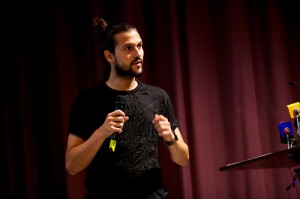
Na de probleemstelling van Stadsdeel West, geven de ontwerpers die zijn gekoppeld aan het stadsdeel een introductie. Een van de ontwerpers is Jorge Manes Rubio. Een mooi voorbeeld van reframing is zijn project Park, Set & Match. Door op slimme wijze een systeem te hacken, het te gebruiken waar het niet voor is bedoeld, transformeerde Jorge een parkeergarage in centraal Londen in een tennisbaan. De parkeergarage is doorgaans alleen toegankelijk voor klanten van supermarkt Tesco, die er gedurende drie uur mogen parkeren. Dat betekent dat de enorme parkeergarage ’s avonds en ’s nachts compleet verlaten en leeg is, terwijl het een gigantische oppervlakte midden in Londen betreft. Jorge ontdekte dat de garage eigenlijk een perfecte tennisbaan is; de lijnen staan er al uitgetekend op de grond.
Door boodschappen te doen bij de Tesco kan men drie uur lang gebruik maken van de ruimte van een parkeerplek in de garage, en er met anderen tennis spelen. Jorge vroeg vervolgens de CCTV beelden op die in de garage continue worden gemaakt. Een gecontroleerde privé-ruimte werd tot een speelse publieke ruimte omgevormd door tactisch met de regels om te gaan.
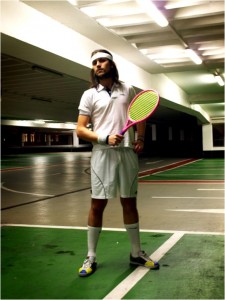
Een ander project van Rubio is street food lighting, waarbij video’s van marktkramen op verlaten plekken in de stad worden geprojecteerd. Onbedoeld bleek dit een effectieve methode om criminaliteit in de stad tegen te gaan. Criminelen houden zich voor zo’n projectie niet graag op.
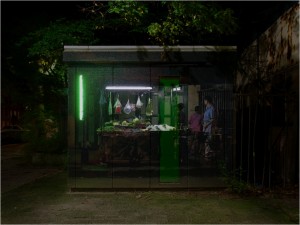
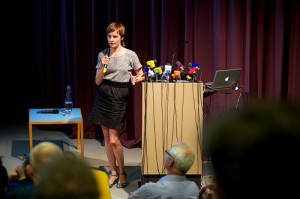
De andere social designers die met het vraagstuk van Stadseel West aan de slag gaan, zijn de dames van Muzus. Zij zijn specialist in het facilliteren van interactie tussen partijen. Ze verdiepen zich in de motivaties van mensen, en komen zo vaak tot zinvolle oplossingen. Door mee te lopen met daklozen in Transvaal in Den Haag kwamen zij erachter dat het verbeteren van de hygiëne hen helpt om makkelijker contact met anderen te maken. Een ander idee was om lege postvakjes op het postkantoor als adres voor daklozen in te richten.
Samen met Jorge Manes Rubio gaat Muzus de komende maanden aan de slag met Stadsdeel West, op zoek naar een nieuwe ingang en aanpak van het probleem en de problematiek op het plein in Amsterdam.

